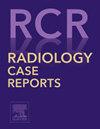Extremely rare bilateral variation of the posterior superior alveolar artery on the maxillary sinus floor observed using CBCT: A case report
Q4 Medicine
引用次数: 0
Abstract
The posterior maxilla is particularly susceptible to bone resorption and poses significant anatomical challenges for surgical interventions, including sinus augmentation and dental implant placement. The Posterior Superior Alveolar Artery (PSAA), which usually courses along the lateral wall of the maxillary sinus, is essential for supplying blood to this area. Nonetheless, variations in the PSAA's position and diameter can increase the risk of complications during and after surgery. We here report the case of a 36-year-old male patient presented for implant treatment in the posterior maxilla. A Cone Beam Computed Tomography (CBCT) scan revealed a rare anatomical variation of the large PSAA, observed bilaterally on the floor of the maxillary sinus instead of its typical lateral wall position. This unusual finding was considered in preoperative planning to prevent potential complications during implant placement. Preoperative CBCT imaging is essential in identifying uncommon anatomical variations of the PSAA to ensure safe and effective surgical outcomes in the posterior maxilla. Early identification of such variations can guide surgical planning, prevent complications, and enhance patient safety.
上颌骨后部特别容易发生骨吸收,对包括上颌窦增量术和牙种植体植入术在内的手术干预造成了巨大的解剖学挑战。后牙槽上动脉(PSAA)通常沿着上颌窦的侧壁走向,对该区域的血液供应至关重要。然而,PSAA 位置和直径的变化会增加术中和术后并发症的风险。我们在此报告了一名 36 岁男性患者的病例,他前来接受上颌后部的种植治疗。锥形束计算机断层扫描(CBCT)发现大 PSAA 存在罕见的解剖变异,双侧均位于上颌窦底,而不是其典型的侧壁位置。在术前规划时考虑了这一异常发现,以防止种植体植入过程中可能出现的并发症。术前 CBCT 成像对于识别 PSAA 不常见的解剖变异至关重要,可确保上颌后牙手术安全有效。早期识别此类变异可以指导手术规划、预防并发症并提高患者安全性。
本文章由计算机程序翻译,如有差异,请以英文原文为准。
求助全文
约1分钟内获得全文
求助全文
来源期刊

Radiology Case Reports
Medicine-Radiology, Nuclear Medicine and Imaging
CiteScore
1.10
自引率
0.00%
发文量
1074
审稿时长
30 days
期刊介绍:
The content of this journal is exclusively case reports that feature diagnostic imaging. Categories in which case reports can be placed include the musculoskeletal system, spine, central nervous system, head and neck, cardiovascular, chest, gastrointestinal, genitourinary, multisystem, pediatric, emergency, women''s imaging, oncologic, normal variants, medical devices, foreign bodies, interventional radiology, nuclear medicine, molecular imaging, ultrasonography, imaging artifacts, forensic, anthropological, and medical-legal. Articles must be well-documented and include a review of the appropriate literature.
 求助内容:
求助内容: 应助结果提醒方式:
应助结果提醒方式:


